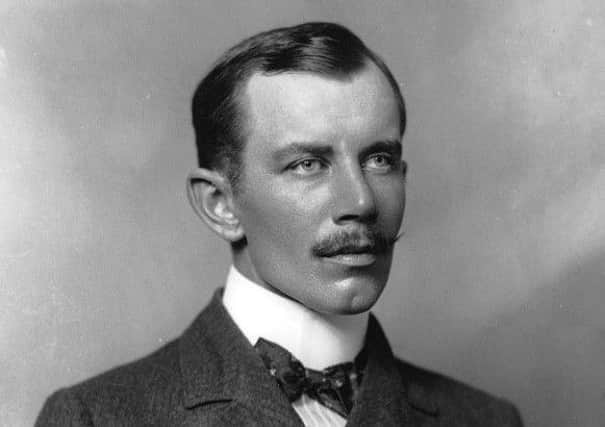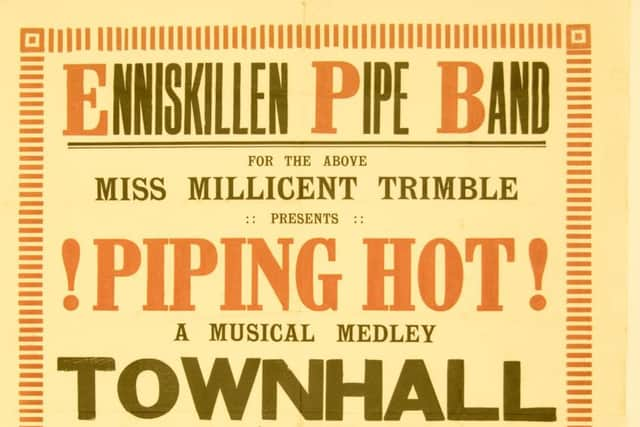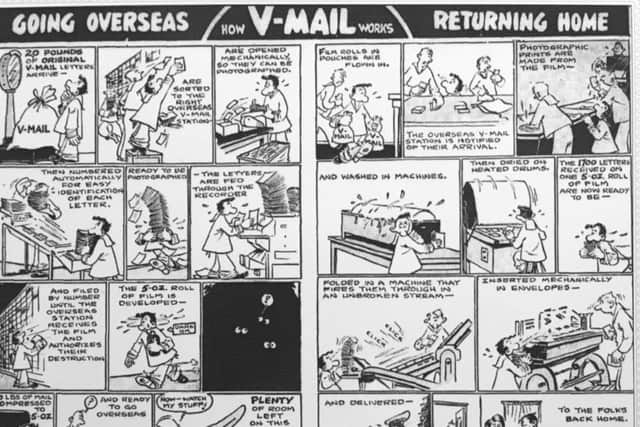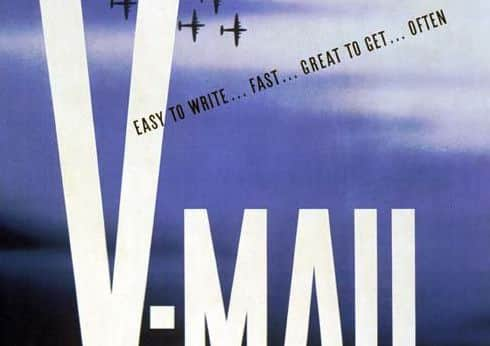V-mails were long known as airgraphs and preceded emails


“Apart from the speed you go at you’re all a bit old hat.” The first documented messaging service was in Egypt around 2400 BC when the Pharaohs circulated their engraved-stone decrees by courier.
Papyrus superseded couriered sandstone which was slow, cumbersome and clogged up First Dynasty mailboxes!
Advertisement
Hide AdAdvertisement
Hide AdThe hand-delivered postal system that evolved probably originated in Ancient Persia.


It continued with varied amendments until new-fangled telegrams, fax machines and telex were overtaken by today’s electronic, digital, media data compression, regarded as epoch-changing.
But e-mail, with its relentlessly updated contemporaries, is long-preceded by wartime V-mail (Victory mail) where bulk correspondence was microfilmed into the merest fraction of its original size and weight.
This was flown by plane to a magnification hub for enlargement and distribution. Though instigated during WWI, V-mail flourished in WWII.
Advertisement
Hide AdAdvertisement
Hide AdBetween 15 June 1942 and 1 April 1945 almost 556,513,800 pieces of V-mail were sent from the USA to military post offices around the world and over 510 million pieces were received from military personnel abroad.


But amazingly, even with V-mail’s obvious advantages, most people still sent ordinary letters!
In 1944, for instance, Allied Navy personnel received 38 million pieces of V-mail, but over 272 million regular letters. The reality of V-mail is perhaps more graphic in pounds weight and post bags.
Over 40 large, canvas, mail bags containing 150,000 letters handwritten on paper and turned into V-mail could be packed into one small mail sack and carried on a single-seater aircraft. That same quantity of mail was reduced dramatically from 2,575 lbs to a mere 45lbs!
Advertisement
Hide AdAdvertisement
Hide AdThe letters or documents became commonly known as airgraphs, and thanks to regular contributor Selwyn Johnston there’s an original airgraph reproduced here today. And besides its little-told technological novelty, the airgraph boasts fascinating origins!


It was sent to Miss Millicent Trimble in 1944. Apart from her significant musical prowess, Miss Trimble, from Selwyn’s home-town of Enniskillen, was renowned and respected for her charitable work, particularly organising money-raising concerts and events during and after WWII.
Selwyn also tells me that she was an Aunt of the internationally renowned Trimble Sisters - Joan and Valerie.
Daughters of William Egbert Trimble, editor and printer of The Impartial Reporter, the pianist-sisters took part in the immensely popular series of lunchtime concerts at the National Gallery in London during WWII whilst volunteering for nursing duties with the Red Cross during the London Blitz.
Advertisement
Hide AdAdvertisement
Hide AdJoan and Valerie Trimble played with most of the leading orchestras in Britain and were widely acclaimed for their weekly appearances on the BBC’s Tuesday Serenade programme, which ran for a decade.
Mr Johnston has kindly shared a poster here for one of their Aunt Millicent’s post-war Armistice Commemorative entertainments starring Barney McCool, Merlin the Magician, Three Gay Girls and Bob the Nut: should The X Factor be eating its heart out too?!
A festive airgraph to Millicent Trimble dated 31 December 1944, from Captain Harry E Irwin of the Central Mediterranean Force, well-illustrates Miss Trimble’s enthusiastic charitable work for the forces.
(And includes a merry quip about Fermanagh’s famously inclement climate!)
Advertisement
Hide AdAdvertisement
Hide Ad“I am writing to thank you, and the ladies of the Legion, for the very welcome parcel which I received a short time ago. Such things help greatly to lessen the large gap between here and home.
“All the Enniskillen fellows are doing well, and fit to stand up to the winter. After Enniskillen, that should never be too difficult. Hoping the New Year will see an end to the necessity for many of your duties, and with best wishes to all. Yours sincerely, Harry R Irwin.”
The system that carried the Captain’s airgraph to Millicent was first mooted in 1918 when Mr. Colin Williamson of the Williamson Print Manufacturing Company met Major-General Sir Percy Girouard, the Managing Director of Armstrong-Whitworths aircraft conglomerate.
The Williamson firm had devised a machine that copied a letter onto 35 mm film and enlarged it again onto bromide paper.
Advertisement
Hide AdAdvertisement
Hide AdInspired by the idea and trying to increase the then meagre payload of airships Sir Percy proposed the system to the Post Office and the Royal Air Force.
But it wasn’t until 1939, long after Sir Percy died, that the RAF purchased Williamson’s continuous paper-processing machine that printed, fixed, washed and dried prints from air-camera negatives.
Gummed letter-sheets (of foldable paper) were mass produced on which a user such as Captain Irwin wrote a message. The correspondence was then reduced to thumb-nail size on microfilm.
The rolls of film were sent to prescribed destinations for developing and enlarging at a receiving station near the addressee.
Advertisement
Hide AdAdvertisement
Hide AdFinally, individual facsimiles of the letter-sheets were reproduced about one-quarter the original size and the miniature mail was then delivered to the addressee.
A General Post Office (GPO) poster of the time claimed that 1,600 letters on film weighed just 5oz, while 1,600 ordinary letters weighed 50 lbs.
Besides their vital wartime benefits airgraphs gained international movie stardom in the 1961-released Breakfast at Tiffany’s starring Audrey Hepburn.
The narrator recounts Hepburn’s Holly Golightly whose dustbin “received V-letters by the bale.” They were torn and shredded.
“‘Remember and miss you’ and ‘please write’ and ‘damn and goddamn’ were the words that recurred most often. And ‘lonesome’ and ‘love.’